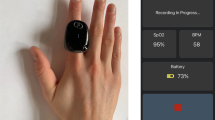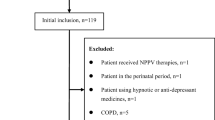Abstract
Obstructive sleep apnea syndrome (OSAS) is a common sleep disorder and related to multiple conditions that cause mortality in adults. In the present study, reliability of SleepStrip, a disposable screening device for detection of OSAS, is tested. In this prospective, nonrandomized double-blinded single cohort study at an academic health center, the performance of the SleepStrip in detecting respiratory events and establishing an SleepStrip score (Sscore) in domestic use were compared to the apnea–hypopnea index (AHI) obtained by the standard polysomnography (PSG) recordings in the sleep laboratory. Forty-one patients who have the PSG results participated the study and wore the SleepStrips at home. Test efficiency rate was 75 % and there was a positive correlation between PSG-AHI scores and Sscores (r = 0.71, p < 0.001). However, diagnostic accuracy analysis showed that the correlation between Sscores and PSG-AHI scores were significant only at AHI > 30 levels. The SleepStrip has 100 % specificity and positive predictive values, but it also has low negative predictive and sensitivity values. The SleepStrip is not a reliable screening test in differential diagnosis among simple snorers, mild, moderate and severe OSAS patients. However, high Sscores highly indicate the presence of moderate–severe OSAS. We can safely send these patients to split-night PSG and continuous, automatic, bi-level positive airway pressure (CPAP/BPAP/APAP) titration at the same night. The SleepStrip may increase the effective use of the sleep laboratories.

Similar content being viewed by others
References
Young T, Palta M, Dempsey J, Skatrud J, Weber S, Badr S (1993) The occurrence of sleep-disordered breathing among middle-aged adults. N Engl J Med 328:1230–1235
Young T, Evans L, Finn L et al (1997) Estimation of the clinically diagnosed proportion of sleep apnea syndrome in middle-aged men and women. Sleep 20:705–706
Findley LJ, Umversat ME, Suratt PM (1988) Automobile accidents involving patients with obstructive sleep apnea. Am Rev Respir Dis 138:337–340
Partinen M, Jamieson A, Guilleminault C (1988) Long-term outcome for obstructive sleep apnoea syndrome patients: mortality. Chest 94:1200–1204
Flemons WW, Whitelaw WA, Brant R et al (1994) Likelihood ratios for a sleep apnea clinical prediction rule. Am J Respir Crit Care Med 50:1279–1285
Hoffstein V, Szalai JP (1993) Predictive value of clinical features in diagnosing obstructive sleep apnea. Sleep 16:118–122
Schlosshan D, Elliott MW (2004) Clinical presentation and diagnosis of the obstructive sleep apnoea hypopnoea syndrome. Thorax 59:347–352
Shochat T, Hadas N, Kerkhofs M, Herchuelz A, Penzel T, Peter HJ, Lavie P (2002) The SleepStripTM: an apnoea screener for the early detection of sleep apnoea syndrome. Eur Respir J 19:121–126
Young T, Peppard PE, Gottlieb DJ (2002) Epidemiology of obstructive sleep apnea a population health perspective. Am J Respir Crit Care Med 165:1217–1239
Ross S, Sheinhait IA, Harrison KJ et al (2000) Systematic review and meta-analysis of the literature regarding the diagnosis of sleep apnea. Sleep 23:519–532
Kingshott RN, Sime PJ, Engleman HM, Douglas NJ (1995) Self assessment of daytime sleepiness: patient versus partner. Thorax 50:994–995
Young T, Shahar E, Nieto FJ et al (2002) Predictors of sleep-disordered breathing in community-dwelling adults: the Sleep Heart Health Study. Arch Intern Med 162:893–900
Ozmen OA, Tüzemen G, Kasapoğlu F, Ozmen S, Coşkun H, Ursavaş A, Karadağ M, Onart S (2011) The reliability of SleepStrip as a screening test in obstructive sleep apnea syndrome. Kulak Burun Bogaz Ihtis Derg 21(1):15–19
Hollingworth L, Tooby M, Roberts D, Hanning CD (2003) Practicality of the Sleepstrip in postal screening for obstructive sleep apnoea. J Sleep Res 12:157–159
Pang KP, Dillard TA, Blanchard AR, Gourin CG, Podolsky R, Terris DJ (2006) A comparison of polysomnography and the SleepStrip in the diagnosis of OSA. Otolaryngol Head Neck Surg 135(2):265–268
Stepnowsky CJ, Orr WC, Davidson TM (2004) Nightly variability of SDB measured over 3 nights. Otolaryngol Head Neck Surg 131:837–843
Author information
Authors and Affiliations
Corresponding author
Rights and permissions
About this article
Cite this article
Dinç, A.E., Yılmaz, M., Tutar, H. et al. Reliability of SleepStrip as a screening test in obstructive sleep apnea patients. Eur Arch Otorhinolaryngol 271, 2813–2818 (2014). https://doi.org/10.1007/s00405-014-3087-2
Received:
Accepted:
Published:
Issue Date:
DOI: https://doi.org/10.1007/s00405-014-3087-2




